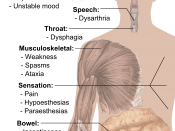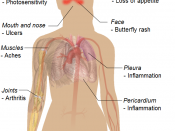Lupus Not many people have heard of the autoimmune disease Lupus, although it is more common than Leukemia, Multiple Sclerosis, and Muscular Dystrophy. Lupus is an autoimmune disease, which can affect any system in the body. This disease makes the body attack its own cells and tissues. The immune system makes antibodies, which are supposed to protect the body, but instead they attack the body's own tissue. Lupus is a chronic disease, which means it is long lasting. It is neither contagious nor infectious (Rosenthal). There are three types of Lupus. The types include Systemic Lupus, Discoid Lupus, and drug induced lupus. Systemic Lupus attacks the skin, joints, blood, lungs, kidneys, heart, brain, and nervous system. Symptoms include arthritis, muscle pain and weakness, fatigue, sun sensitivity, hair loss, "butterfly"ÃÂ or malar rash across cheeks Discoid Lupus affects the skin. Symptoms include different skin rashes, photosensitivity, and sometimes mouth or nose ulcers.
Drug induced lupus is from taking certain prescription medicines. This is not serious, usually after you stop taking the drug the symptoms will stop. This doesn't usually involve or central nervous system (Messick). Lupus can be triggered at puberty, after childbirth, through sunlight, after prolonged course of medication, during menopause, after viral infection, or as a result of trauma. Lupus occurs in different ethnic groups. The reason for this is not known. In Caucasians the ratio is 1:1000, African Americans 1:250, and in Latinos 1:500. Ninety percent of the affected are women. Eighty percent of people develop Lupus between the ages of fifteen and forty-five (Rosenthal). Lupus has no exact cause. It is caused by a combination of things. The genetic makeup of a person and the exposure to certain trigger factors mentioned above. It is suspected that people inherit something from their parents that may cause them to...


